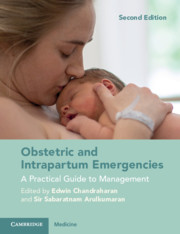Book contents
- Obstetric and Intrapartum Emergencies
- Obstetric and Intrapartum Emergencies
- Copyright page
- Contents
- Contributors
- Preface
- Preface to the First Edition
- Acknowledgements
- Section 1 General Principles
- Section 2 Algorithms for Management of the Top Five ‘Direct Killers’
- Section 3 Intrapartum Emergencies
- Section 4 Postpartum Emergencies
- Section 5 Medical and Surgical Emergencies During Pregnancy
- Section 6 Anaesthetic Emergencies During Pregnancy
- Section 7 Neonatal Emergencies and the Management of Immediate Neonatal Problems
- Section 8 Management of Anticipated and Non-anticipated Emergencies in Pregnancy
- Section 9 Setting-Up Skills and Drills Training in Maternity Services and Reducing Avoidable Harm
- Chapter 41 Addressing Human Factors in Obstetric Emergencies
- Chapter 42 Setting Up and Running Labour Ward Fire Drills
- Chapter 43 Simulation Training for Obstetric Emergencies
- Chapter 44 Learning from Mothers and Babies
- Chapter 45 Risk Management
- Index
- References
Chapter 41 - Addressing Human Factors in Obstetric Emergencies
from Section 9 - Setting-Up Skills and Drills Training in Maternity Services and Reducing Avoidable Harm
Published online by Cambridge University Press: 06 May 2021
- Obstetric and Intrapartum Emergencies
- Obstetric and Intrapartum Emergencies
- Copyright page
- Contents
- Contributors
- Preface
- Preface to the First Edition
- Acknowledgements
- Section 1 General Principles
- Section 2 Algorithms for Management of the Top Five ‘Direct Killers’
- Section 3 Intrapartum Emergencies
- Section 4 Postpartum Emergencies
- Section 5 Medical and Surgical Emergencies During Pregnancy
- Section 6 Anaesthetic Emergencies During Pregnancy
- Section 7 Neonatal Emergencies and the Management of Immediate Neonatal Problems
- Section 8 Management of Anticipated and Non-anticipated Emergencies in Pregnancy
- Section 9 Setting-Up Skills and Drills Training in Maternity Services and Reducing Avoidable Harm
- Chapter 41 Addressing Human Factors in Obstetric Emergencies
- Chapter 42 Setting Up and Running Labour Ward Fire Drills
- Chapter 43 Simulation Training for Obstetric Emergencies
- Chapter 44 Learning from Mothers and Babies
- Chapter 45 Risk Management
- Index
- References
Summary
The Importance of ‘Human Factors’ for Maternity Teams
- Type
- Chapter
- Information
- Obstetric and Intrapartum EmergenciesA Practical Guide to Management, pp. 297 - 306Publisher: Cambridge University PressPrint publication year: 2021

